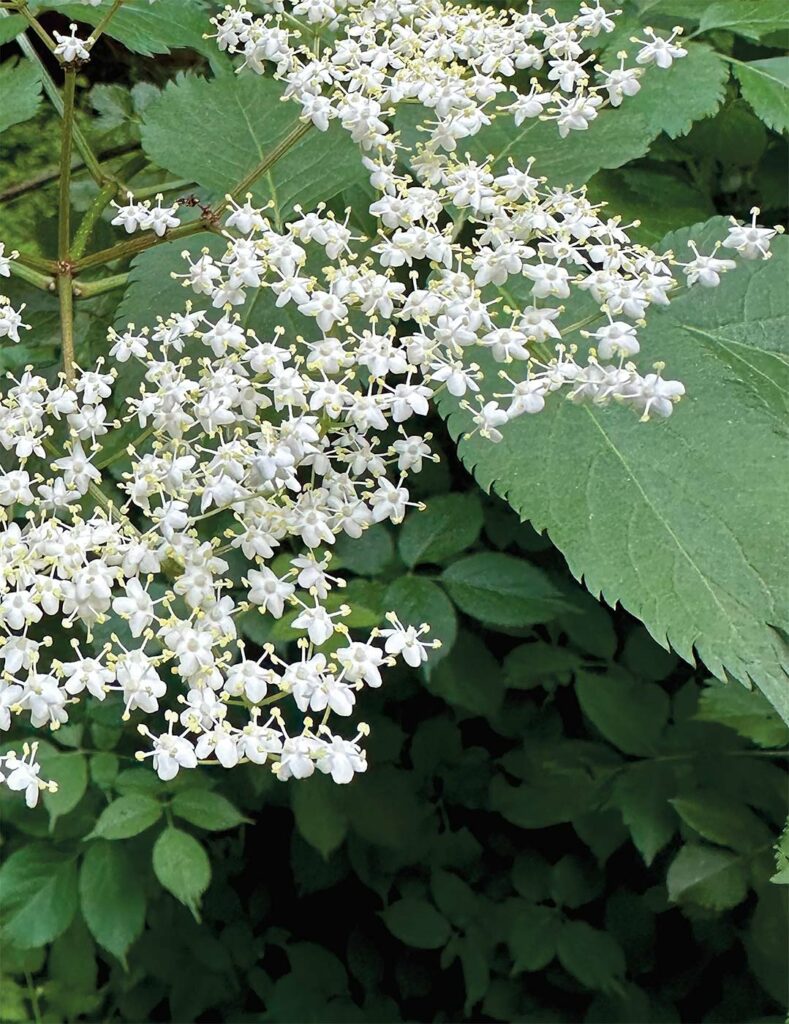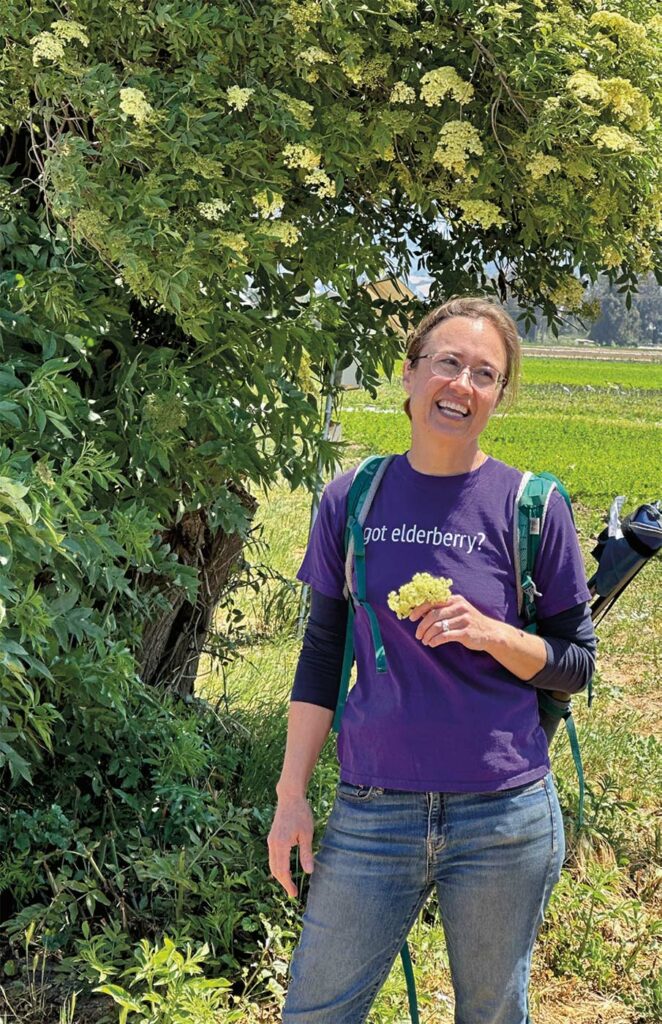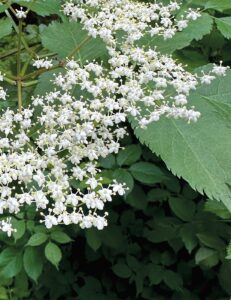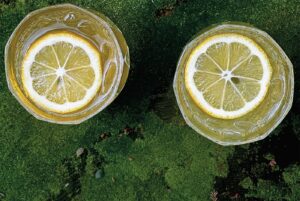
Nature’s springtime treat
PHOTOGRAPHY BY JESSICA TUNIS
In our local woods and creekside canyons, the creamy umbels of elderflower begin to flare against the lush green vegetation in late spring. Elderflowers, once pollinated, will eventually grow and swell to become elderberries, and while both flower and fruit are delicious and medicinal in their own right, this is the time of year to celebrate and utilize the flowers that come before the fruit.
In our area, elders appear as a mid-size shrub or small tree, deciduous in winter, leafing and flowering out in late spring, and bearing dark clusters of elderberries in the fall. Elderflowers have a light, delicate fragrance and flavor that is easily captured in a simple syrup or infusion. You may have tasted it in cocktails like Pimm’s cup, made with the popular St. Germain liqueur.
Grouped in lacy, flat-topped umbels at the tips of branches, the flowers seem to float above the foliage, making easy access for pollinators and foragers alike. But before a forager deigns to pick the delicate blooms, there are some important considerations.
Worldwide, there are many species of elderflower/ elderberry, but the ones we find most commonly growing wild in the Monterey Bay area are the blue Sambucus cerulea and Sambucus mexicana, as well as the poisonous red elder, Sambucus racemosa.
While all members of this genus contain a small amount of cyanogenic glycosides, and therefore warrant moderate consumption, the red elder has higher levels of cyanide, and is considered unsafe for consumption in either flower or berry form. While there are subtle differences in the foliage that may enable an experienced forager to determine whether the fruit is red or blue, a good general rule would be to only harvest flowers from a plant that is known to have blue-black berries. If you have never seen the color of the summer fruits, don’t harvest the spring flowers!
While the thought of such toxins surely merits caution, it shouldn’t be a barrier to experimentation. The quaint, pure fragrance of elderflowers is worth the care of identification and harvest. It somehow captures the essence of the late-spring season, cool but warming, full of delicate vigor. For those who prefer to forage in a market (or aren’t sure about species ID) it’s possible to find dried elderflowers in bulk at several local health food stores, as well as online.
Once a forager is sure of their identification, the flowers are easy to harvest, having a sturdy central stem that makes picking easy. As with all wild-crafted ingredients, be aware that these flowers are an important source of nectar and pollen, and the berries that will follow the fruits are a reliable food source for birds and mammals later in the season. This resource, like many, is abundant but not infinite, so be respectful of other beings as you plan your harvest.

ELDERFLOWER TOUR
To learn more about elderflowers and pick some for yourself, join Katie Reneker of Carmel Berry Co., and Nathan Harkleroad of ALBA for an Edible LIVE tour and lunch on Saturday, May 18 from 11am to 2pm. Participants will have a chance to visit elder trees in bloom on the ALBA (Agricultural and Land-Based Training Association) farm in Salinas, learn about the healthful properties of elderflowers and elderberries, and taste foods made with these extraordinary natural ingredients.
A word of thanks to elder herself might be wise as well; elder is cited often in folklore as a powerful spirit, and it is advised to ask permission before cutting an elder tree, lest misfortune follow.
It’s best to harvest elderflower in the cool morning hours, as heat lessens the delicate fragrance and dilutes its potency. Choose only fresh, young flowers; older flowers that have begun to shrivel will impart a musty flavor.
Give the freshly harvested umbels a little shake, then hang them upside down in a paper bag for an hour to dislodge any bugs that may have made the flowers their home; these flowers are a favorite of many small pollinators. The green parts of the stem and calyx have a bitter flavor that can lead to stomach upset in sensitive individuals, so it’s best to pluck or shake the individual flowers off of the branching green structure of the umbel, removing all of the green parts so that only the tiny white flower is used.
Once your elderflowers are separated from the stem, there are a few favorite, timetested ways to capture their fleeting flavor. In their simplest form, they can be scattered over a cake or baked into fritters or pancakes, to showcase both flavor and form, or muddled in cocktails.
The flowers can be dried and used in teas to support the immune system. Because the fresh flowers contain a generous amount of wild yeast, elderflowers can also be used to create a wild-fermented natural champagne—a light, sparkling beverage with a small amount of alcohol from a short (24– 48 hour) fermentation.
Alternatively, their flavors can be captured in a simple syrup and used in cocktails, as a base for sorbets, poured over cakes or baked into custards. Katie Reneker, a local elderberry advocate and founder of Carmel Berry Co., has developed a line of elderflower and elderberry products using America-grown elder. Her website carmelberry.com has a wealth of recipes that make use of her own elderflower syrup, for those seeking further inspiration.


About the author
Jessica Tunis lives in the Santa Cruz Mountains and spends her time tending gardens, telling stories, and cultivating adventure and good food in wild places.
-
Jessica Tunishttps://www.ediblemontereybay.com/author/jtunis/
-
Jessica Tunishttps://www.ediblemontereybay.com/author/jtunis/
-
Jessica Tunishttps://www.ediblemontereybay.com/author/jtunis/
-
Jessica Tunishttps://www.ediblemontereybay.com/author/jtunis/


